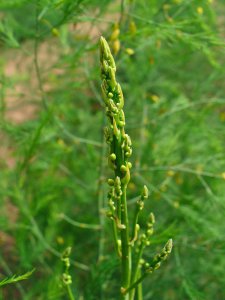When it comes to Asparagus (Asparagus Officinalis), the culinary world is abundant with recipes to sate any palate. What you might not know however, is that the asparagus growing in the wild is identical to the stuff you can find in your local grocery store produce section. Asparagus has escaped cultivation and can now be found growing feral in every state in the United States and every Province in Canada. It even grows down into some parts of Mexico.

Asparagus in the wild is in fact so widespread that the USDA has a useful map for locating which counties have confirmed asparagus growth. With a little bit of legwork and some planning, you can add this abundant vegetable to your pantry every spring.
The Where, When, and How to find Asparagus
To begin, with Wild Asparagus you must do some hunting. Your best bet at finding asparagus is to look for older plants the fall before you want to find sprouts.

An herbaceous perennial, the fully grown plants die back every winter and are reduced to a scraggly root crown. This root crown can live for up to fifty years!
In the fall these plants can be quite easy to find, as they can grow up to six feet tall and ferny, like fennel or dill. The plants turn a bright yellow shade before they die back that makes them stand out from other similar sized plants.
There are male and female asparagus plants, and in the fall the female ones grow bright red berries among their ferny foliage. These berries are unfortunately toxic, so don’t eat them!
To find Asparagus, look for moist alkaline or saline soil. In the pacific northwest, brackish swamps are a good place to start! Asparagus likes to grow in full sun to very light shade, so you wont find it in the woods or areas where it can’t get a clear view of the sky.
Asparagus enjoys being close to but not in water, so look along drainage ditches, the edges of marshes, or along river and stream edges. Unless the road is rarely used and rural, avoid any plants growing along the sides of roads.
Harvesting
When you go looking for Asparagus, be sure to bring along sharp shears or a knife. If you happen to find shoots and don’t have either handy, snapping the shoots as close to dirt level as you can get works just as well.
Wild Asparagus grows quickly, about an inch a day. Start looking in early spring, which will vary from place to place. In the Pacific Northwest, you can start looking in early February, or when wild mustard begins to bloom.
Look for sprouts that are young with tight tops. As the plant grows, these tops will loosen and begin to branch out into the beginnings of the mature, branching plant. Avoid these sprouts, they are already past their edibility stage. Asparagus crowns set out shoots all through spring, so check back often. But leave a few sprouts to grow up, or you risk damaging or even killing the plant.
Eating and Preparing
When it comes to preparing Asparagus shoots, the opportunities are near endless. For many there is just no beating the crunch and flavor of raw, freshly foraged asparagus. If that doesn’t suit your palate, asparagus can be boiled and roasted. You can tempura batter and fry it. You can chop it and throw it into a stew.
In most cases, you’ll want to snap off the woodier base of the shoot and enjoy the tender tops.

In places where it grows abundantly, you may find yourself with so much on hand that you want to find ways to preserve your harvest. Pickling is a popular method, but some find that the texture may suffer after long periods. To freeze Asparagus, blanching in boiling water and then shocking in an ice bath before storing in airtight resealable bags is the way to go.
Cautions & Considerations
Mature female asparagus plants grow bright red berries in the fall just before they go dormant. These berries are mildly poisonous and should never be consumed!

Foraging asparagus by hand may lead to some individuals experiencing contact dermatitis where it has touched their skin. Use of gloves is strongly advised.
Eating asparagus in large quantities may cause kidney irritation. As asparagus is a known diuretic and laxative, over consumption may cause bowel irritation in some people.
Asparagus is considered a highly invasive plant. So you can harvest the spears to your hearts content when you find one of these plants growing in the wild. The plants have an extensive root structure and are known for re-growing from even the smallest root scraps. Therefore, overharvesting would be particularly difficult to achieve. But if you are concerned about killing the plant, or would like to come back to harvest for multiple seasons, leave a few of the spears behind to grow up for the next year.
—————Written by Taylor Calderon
Taylor Calderon is a freelance graphic designer and writer from South Texas. They have a passion for art, food, and living self-sufficiently. They enjoy writing on a variety of topics and issues, from sustainable living to botanicals and foraging, to travel and culture. To see more of their work, you can view their portfolio at www.flamingink.art
Many of our readers find that subscribing to Eat The Planet is the best way to make sure they don't miss any of our valuable information about wild edibles.
See our privacy policy for more information about ads on this site






